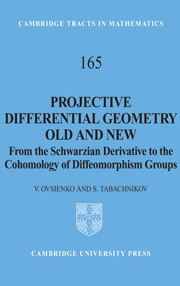 Projective Differential Geometry Old and New
Projective Differential Geometry Old and New Published online by Cambridge University Press: 14 August 2009
Lie algebras of vector fields on a smooth manifold M became popular in mathematics and physics after the discovery of the Virasoro algebra by Gelfand and Fuchs in 1967. Gelfand and Fuchs, Bott, Segal, Haefliger and many others studied cohomology of Lie algebras of vector fields and diffeomorphism groups with coefficients in spaces of tensor fields. This theory attracted much attention in the last three decades, many important problems were solved and many beautiful applications, such as characteristic classes of foliations, were found.
In this chapter we consider cohomology of Lie algebras of vector fields and of diffeomorphism groups with coefficients in various spaces of differential operators; this is a generalization of Gelfand–Fuchs cohomology. Only a few results are available so far, mostly for the first cohomology spaces. The main motivation is to study the space of differential operators Dλ,μ(M), viewed as a module over the group of diffeomorphisms.
This cohomology is closely related to projective differential geometry and, in particular, to the Schwarzian derivative. The classic Schwarzian derivative is a 1-cocycle on the group Diff(S1), related to the module of Sturm–Liouville operators. Multi-dimensional analogs of the Schwarzian derivative are defined as projectively invariant 1-cocycles on diffeomorphism groups with values in spaces of differential operators.
To save this book to your Kindle, first ensure [email protected] is added to your Approved Personal Document E-mail List under your Personal Document Settings on the Manage Your Content and Devices page of your Amazon account. Then enter the ‘name’ part of your Kindle email address below. Find out more about saving to your Kindle.
Note you can select to save to either the @free.kindle.com or @kindle.com variations. ‘@free.kindle.com’ emails are free but can only be saved to your device when it is connected to wi-fi. ‘@kindle.com’ emails can be delivered even when you are not connected to wi-fi, but note that service fees apply.
Find out more about the Kindle Personal Document Service.
To save content items to your account, please confirm that you agree to abide by our usage policies. If this is the first time you use this feature, you will be asked to authorise Cambridge Core to connect with your account. Find out more about saving content to Dropbox.
To save content items to your account, please confirm that you agree to abide by our usage policies. If this is the first time you use this feature, you will be asked to authorise Cambridge Core to connect with your account. Find out more about saving content to Google Drive.